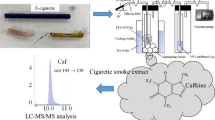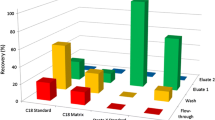Abstract
We developed an analytical method for analyzing electronic cigarette (E-cigarette) smoke, and measured the carbonyl compounds and volatile organic compounds generated by 10 brands of second-generation E-cigarettes. A glass filter (Cambridge filter pad) for particulate matter and a solid sorbent tube packed with Carboxen-572 for gaseous compounds were used to collect E-cigarette smoke. These were then analyzed using a two-step elution method with carbon disulfide and methanol, followed by high-performance liquid chromatography (HPLC) and gas chromatography mass spectrometry (GC/MS). Formaldehyde (FA), acetaldehyde (AA), acetone (AC), acrolein (ACR), propanal (PA), acetol (AT), glyoxal (GO), and methyl glyoxal (MGO) were detected by HPLC in some E-cigarettes. Propylene glycol (PG), glycerol (GLY), and some esters were detected by GC/MS. GO and MGO exist mainly as particulate matter. AA, AC, ACR, PA, and AT exist mainly as gaseous compounds. FA exists as both particulate matter and gaseous compounds. These carbonyl compounds have carbon numbers C1–C3. The main components of E-liquid are PG (C3) and GLY (C3). Therefore, the oxidation of liquids, such as PG and GLY in E-cigarettes upon incidental contact with the heating element in E-cigarette, is suggested as being a possible cause for carbonyl generation. When the puff number exceeds a critical point, carbonyl generation rapidly increases and then remains constant. The results of this study are now being used to determine the following E-cigarette smoking protocol: puff volume, 55 mL; puff duration, 2 s; and puff number, 30. E-cigarette analysis revealed very large variation in carbonyl concentration among not only different brands, but also different samples of the same product. Typical distributions of carbonyl concentration were not observed in any of the E-cigarettes tested, and the mean values greatly differed from median values.
Similar content being viewed by others
References
D. Cressey, Nature, 2013, 501, 473.
H. A. Gilbert, Patent US3200819 Smokeless non-tobacco cigarette, 1965.
T. Schripp, D. Markewitz, E. Uhde, and T. Salthammer, Indoor Air, 2013, 23, 25.
S. Uchiyama, K. Ohta, Y. Inaba, and N. Kunugita, Anal. Sci., 2013, 29, 1219.
M. Laugesen, “Safety Report on the Ruyan® E-cigarette Cartridge and Inhaled Aerosol”, 2008, Health New Zealand Ltd., Christchurch, New Zealand
U. S. Food and Drug Administration (FDA), “FDA Warns of Health Risks Posed by E-cigarettes”, Consumer Health Information, 2009, http://www.fda.gov/downloads/ForConsumers/ConsumerUpdates/UCM173430.pdf.
L. Kosmider, A. Sobczak, M. Fik, J. Knysak, M. Zaciera, J. Kurek, and M. L. Goniewicz, Nicotine Tob. Res., 2014, 16, 1319.
K. Ohta, S. Uchiyama, Y. Inaba, H. Nakagome, and N. Kunugita, Bunseki Kagaku, 2011, 60, 791.
S. Uchiyama, Y. Inaba, and N. Kunugita, J. Chromatogr. A, 2010, 1217, 4383.
S. Uchiyama, T. Tomizawa, Y. Inaba, and N. Kunugita, J. Chromatogr. A, 2013, 1314, 31.
Health Canada, Official Method T-115, “Determination of “Tar”, Nicotine and Carbon Monoxide in Mainstream Tobacco Smoke”, December 1999, Ottawa, Canada K1A 0K9.
S. Uchiyama, H. Hayashida, R. Izu, Y. Inaba, H. Nakagome, and N. Kunugita, J. Chromatogr. A, 2015, 1426, 48.
K. Bekki, S. Uchiyama, K. Ohta, Y. Inaba, H. Nakagome, and N. Kunugita, Int. J. Environ. Res. Public Health, 2014, 11, 11192.
M. E. Counts, M. J. Morton, S. W. Laffoon, R. H. Cox, and P. J. Lipowicz, Regulatory Toxicology and Pharmacology, 2005, 41, 185.
Cooperation Centre for Scientific Research Relative to Tobacco (CORESTA), Recommended Method No. 74, “Determination of Selected Carbonyls in Mainstream Cigarette Smoke by High Performance Liquid Chromatography (HPLC)”, March 2013.
Acknowledgments
This research is partially supported by the Health and Labour Science Research Grants from Ministry of Health, Labour and Welfare of the Japanese Government, and the Practical Research Project for Life-Style Related Diseases Including Cardiovascular Diseases and Diabetes Mellitus from Japan Agency for Medical Research and Development, AMED. We also gratefully acknowledge Sigma-Aldrich for technical support.
Author information
Authors and Affiliations
Corresponding author
Electronic supplementary material
Rights and permissions
About this article
Cite this article
Uchiyama, S., Senoo, Y., Hayashida, H. et al. Determination of Chemical Compounds Generated from Second-generation E-cigarettes Using a Sorbent Cartridge Followed by a Two-step Elution Method. ANAL. SCI. 32, 549–555 (2016). https://doi.org/10.2116/analsci.32.549
Received:
Accepted:
Published:
Issue Date:
DOI: https://doi.org/10.2116/analsci.32.549




